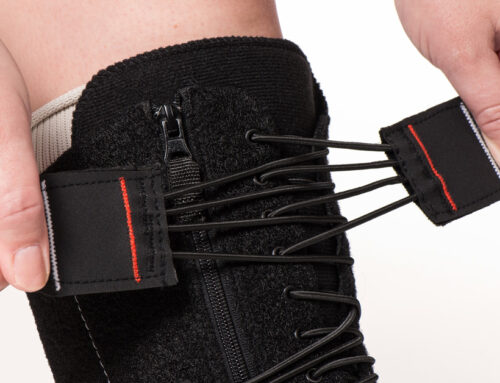Providers can dispense the EXTREMIT-EASE® Compression Garment directly to patients. Patients enjoy being given the product they need, rather than trying to fill a prescription. Furthermore, EXTREMIT-EASE is much easier for patients to apply than other compression garment types. EXTREMIT-EASE opens up all the way with a zipper down the front, allowing patients to easily apply the garment to their lower leg without attempting to apply something that is too tight. Ease of use contributes to better compliance which contributes to better outcomes.
Coverage
The EXTREMIT-EASE Compression Garment is considered a surgical dressing and, as such, it is coverage is governed by the Durable Medical Equipment Medicare Administrative Contractor (DMEMAC) Local Coverage Determination, “Surgical Dressings” (L33831). According to this policy, in order for EXTREMIT-EASE to be covered, a patient must have a wound that was either surgically created or debrided and demonstrates the medical necessity for compression. EXTREMIT-EASE can serve as either a primary dressing or a secondary dressing. In the case that it serves as a secondary dressing, a qualifying primary dressing may also be dispensed at the same time.
Frequency
One medically necessary EXTREMIT-EASE garment per leg is covered by the DMEMACs once per six months, per leg. After six months, another garment is covered only if the patient still has a wound that was either surgically created or debrided and demonstrates the medical necessity for compression.
What If The Patient Does Not Still Have A Wound?
In dealing with venous leg ulcers, oftentimes prevention is just as important as treatment. After six months of use of EXTREMIT-EASE it is often the case that the patient does not have any wounds that qualify for coverage of another garment, but continued use is desired and required. In this situation, another garment is not covered and the patient may choose to pay out of pocket for it.
Conclusion
The EXTREMIT-EASE Compression Garment is an excellent compression option and is covered by DMEMACs once every six months for qualifying wounds.
References
- Erickson CA, Lanza DJ, Karp DL, Edwards JW, Seabrook GR, Cambria RA, Freischlag JA, Towne JB. Healing of venous ulcers in an ambulatory care program: the roles of chronic venous insufficiency and patient compliance. J Vasc Surg. 1995 Nov;22(5):629-36. doi: 10.1016/s0741-5214(95)70051-x. PMID: 7494367.
- Local Coverage Determination (LCD) Surgical Dressings L33831

Dr. Jeffrey D. Lehrman, DPM, FASPS, MAPWCA, CPC, CPMA
Dr. Lehrman is a podiatrist practicing in Fort Collins, CO and operates Lehrman Consulting, LLC which provides consultation services regarding coding, compliance and documentation. Dr. Lehrman is a Certified Professional Coder and Certified Professional Medical Auditor. He serves as a staff liaison at the AMA CPT® Editorial Panel meetings where CPT codes are created, edited, and deleted. He is a Diplomate of the American Board of Foot and Ankle Surgery, Fellow of the American Society of Podiatric Surgeons, and is recognized as a “Master” by the American Professional Wound Care Association. Dr Lehrman is a Fellow of the American Academy of Podiatric Practice Management, Past Director of the American Professional Wound Care Association Board of Directors, and is a Past Chairman of the Board of the American Society of Podiatric Surgeons. Dr. Lehrman is also on the editorial advisory board of the journal WOUNDS.





